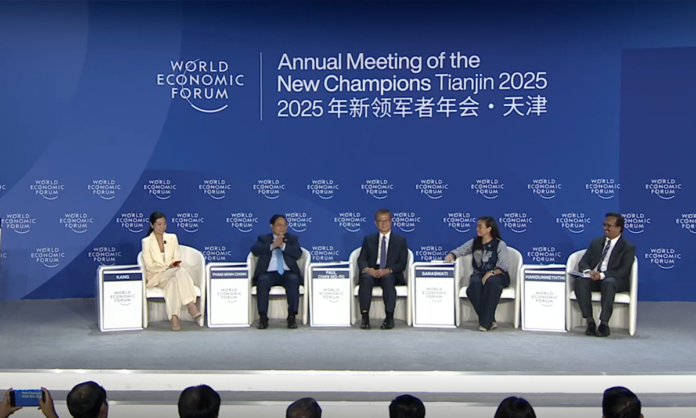“Is Asia’s Century at Risk,” a breakout forum of the 2025 Summer Davos Forum, is held in Tianjin, North China, on June 25, 2025. Photo: Screenshot of the forum’s official video recording
The 16th Annual Meeting of the New Champions of the World Economic Forum—also known as “Summer Davos”—kicked off on Tuesday in Tianjin Municipality. Among its key events, the sub forum “Is Asia’s Century at Risk?” began on Wednesday, convening policymakers, finance chiefs, and regional leaders to debate whether Asia’s impressive economic ascendancy can withstand intensifying geopolitical and trade pressures.
Financial Secretary of the Hong Kong Special Administrative Region Paul Chan Mo-po pushed back against concerns that Hong Kong’s unique characteristics and geopolitical positioning might deter international investors.
Speaking at the forum, Chan pointed to the city’s resilient financial performance as a key indicator of investor confidence. Last year, Hong Kong’s stock market saw an 18 percent increase in market capitalization, he said. So far this year, 15 percent of new investors and trading activity have come from the US and Europe, which clearly “shows that investors are using their capital to cast a vote of confidence in our part of the world.”
Chan also underscored data from recent business sentiment surveys. According to the survey done by the American Chamber of Commerce, American businesses in Hong Kong, about 70 percent of them, are also saying that, well, they don’t think the national security law interferes with any of their businesses and it doesn’t affect their businesses at all. More than 60 percent of them are contemplating expansion in Hong Kong. Similar studies have been done by the Japanese Chamber of Commerce with similar results, he said.
Pham Minh Chinh, Prime Minister of Vietnam, Office of the Government of Vietnam, said that “the wave of development in the Asia-Pacific cannot be resisted.” The rise of the region cannot be hindered, he said. “We are confident that Asia is endowed with sufficient foundation and groundwork to continue growing, advancing, and claiming its position.”
Pham called for the creation of an Asian Innovation Network that would leverage platforms like the forum and China’s central role to foster collaboration among research institutions, universities, and enterprises across the region. He also proposed the development of an Asian Innovation Information Portal, a digital platform designed to better support small and medium-sized enterprises, start-ups, and young innovators.
Vietnam is ready to be part of these forward-looking ideas and initiatives, Pham said, expressing his hope to engage more actively in regional dialogues alongside China and other partners to jointly advance these efforts.
He expressed confidence in the arrival of the Asian Century, saying that with mutual trust, shared responsibility, and decisive action, the region is seizing opportunities—not just facing challenges—to drive development, peace, and cooperation globally.
In response to a question on whether the recent [US] tariff announcements-such as the one on April 2-represent a warning signal or a planned shift in global trade dynamics, particularly regarding China’s evolving role and the future of Asian manufacturing and exports to the US, Sunil Handunneththi, Minister of Industry and Entrepreneurship Development of Sri Lanka, said he found the topic highly relevant. He viewed the opportunity to participate in the Annual Meeting of the New Champions in China as valuable for regional dialogue.
Handunneththi remarked that the 21st century, in his view, belongs to Asia, as countries such as China, Vietnam, India, Japan, and Sri Lanka, while differing in scale, share common development models and external support mechanisms. He expressed appreciation for China’s role—particularly through Belt and Road cooperation with Sri Lanka’s port cities.
Handunneththi emphasized that while Asia is confronted with a range of external pressures—including geopolitical risks, demographic shifts, environmental threats, and internal political complexities—the region continues to hold significant untapped potential. He suggested that short-term uncertainties should not obscure long-term development opportunities, and stressed the importance of using the current period of economic slowdown to address structural issues and strengthen regional capacity for future growth.

